
by Martin Lockley Monday, April 18, 2016
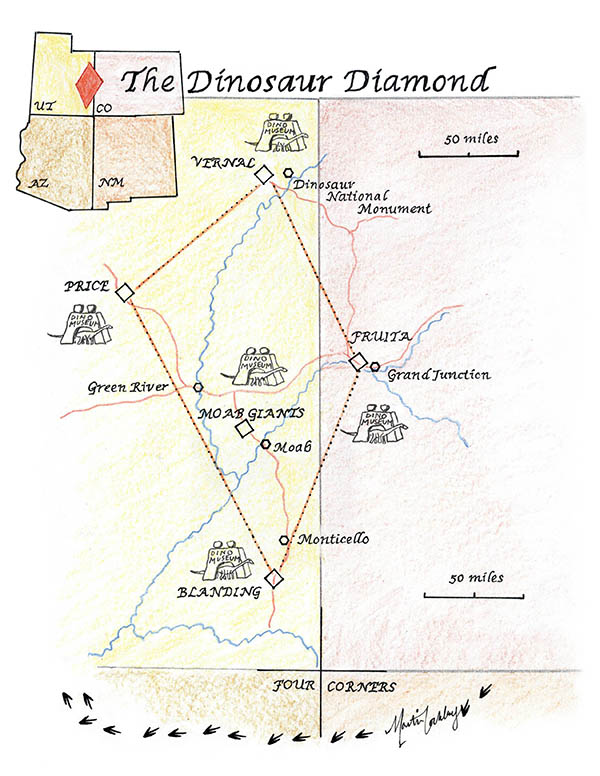
Dinosaur Diamond Map. Credit: Martin Lockley.
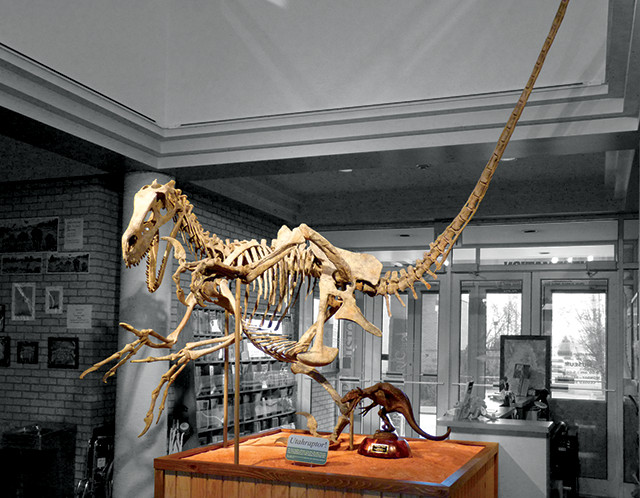
A mounted skeleton of Utahraptor, the largest-known dromaeosaurid, at the Prehistoric Museum in Price, Utah. Credit: Christine K. Trease.
The Prehistoric Museum in Price, Utah, the western point of the Dinosaur Diamond, now affiliated with Utah State University Eastern, was founded as a tourist attraction in the early 1960s with the acquisition of a complete <em class=““italic”>Allosaurus replica for $2,250. Situated amid the Price-Helper coal mining district, the museum contains many tracks of hadrosaurs and ceratopsians extracted from the coal mines. The museum was expanded in the 1990s and now contains mounted skeletons of Utahraptor and ceratopsians.
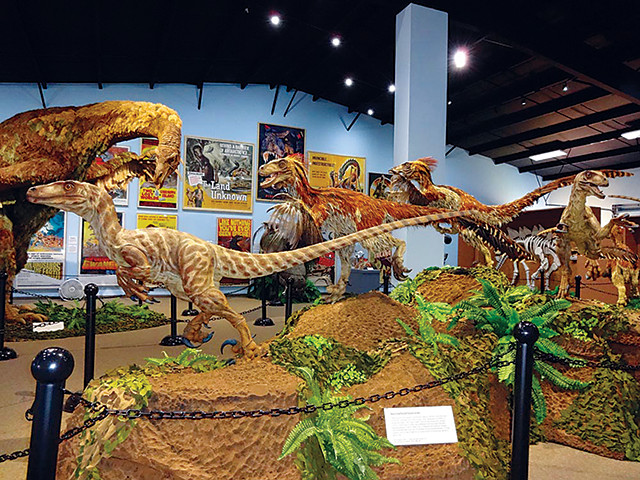
In Blanding's Dinosaur Museum, a feathered Therizinosaurus towers over a pack of Deinonychus, sculpted by museum co-founder Stephen Czerkas. Credit: ©2013, The Dinosaur Museum, Blanding, Utah.
The southernmost point of the Dinosaur Diamond, the Dinosaur Museum in Blanding, Utah, was founded in 1995 by the late Stephen Czerkas and his wife Sylvia, both renowned dinosaur artists. Stephen is famous for correcting ill-conceived reconstructions of dinosaurs like Stegosaurus and Diplodocus. The museum displays include a diverse array of Mesozoic animals exhibited as skeletons and as fleshed-out sculptures, many with feathers. The exhibits also contain tracks and a large number of historically significant artifacts related to dinosaurs and the media, including antique books, prints, famous paintings, sketches and movie props and posters.
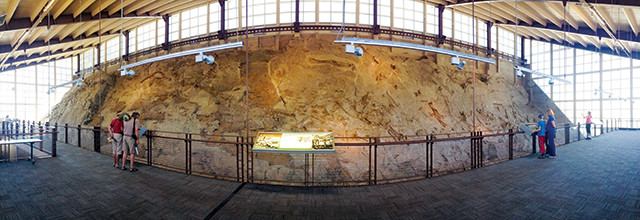
The Quarry Exhibit Hall at Dinosaur National Monument allows visitors to view a wall of approximately 1,500 dinosaur bones in situ, including Allosaurus, Apatosaurus, Camarasaurus, Diplodocus and Stegosaurus. Credit: Brittany Woiderski, CC BY 2.0.
Dinosaur National Monument, the northernmost point of the Dinosaur Diamond, is centered on a large dinosaur quarry found in 1908 in the Morrison Formation near Jensen, Utah. It has historically been the most-visited dinosaur destination in the region. Most of Dinosaur National Monument extends east from the quarry for about 50 kilometers into remote Colorado terrain north of the small settlement of Dinosaur, Colo. The Utah Field House of Natural History State Park Museum is 19 kilometers west of the quarry, in Vernal, Utah. This museum was founded in the late 1940s and was greatly enlarged at a new site in 2004.
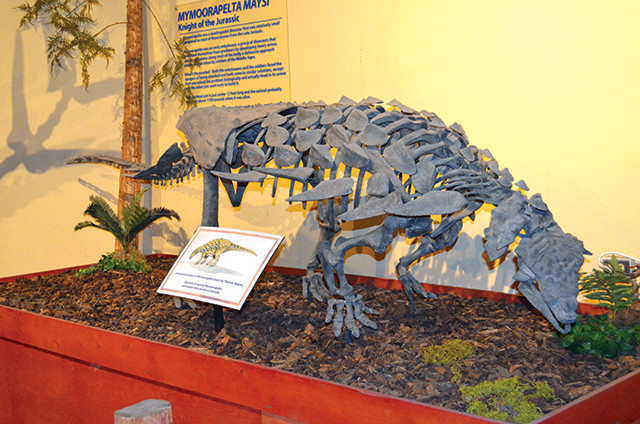
Mymoorapelta maysi skeleton from the Late Jurassic at Dinosaur Journey. Credit: Rob Gay, Museums of Western Colorado.
The eastern point of the Dinosaur Diamond is demarcated by Dinosaur Journey in Fruita, Colo., one of three Museums of Western Colorado destinations dating back to the mid-1960s. The other two are the Museum of the West and Cross Orchards Historic Site, both in Grand Junction. Dinosaur Journey was established in Fruita, just west of Grand Junction, in 2000, and is located near important paleontological sites in the Morrison Formation, including Dinosaur Hill, Riggs Hill, the Fruita Paleontological Area and Rabbit Valley. The exhibits mostly contain dinosaurs and other reptiles from the Morrison Formation, as well as an assortment of Mesozoic tracks from the Western Slope region.
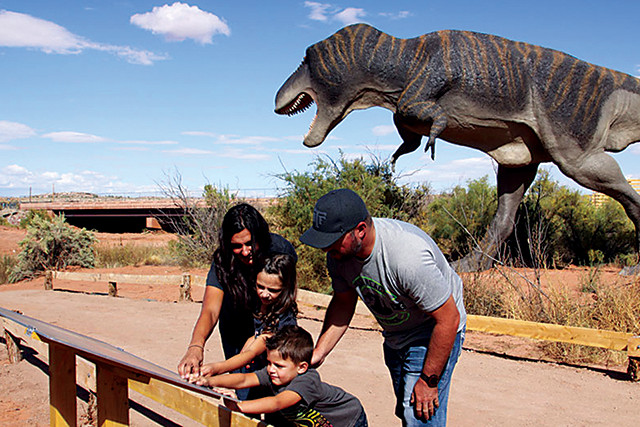
Visitors see a life-sized Tyrannosaurus rex and read about this iconic dinosaur on interpretive signs along the Moab Giants outdoor trail. Credit: Moab Giants.
Moab Giants is a new paleontological museum created in 2015 in Moab, Utah, in the heart of the Dinosaur Diamond. Moab Giants, a for-profit museum, was designed after the model of successful dinosaur museums in Poland at Baltów and Krasiejów, which have both outdoor and indoor components, as well as strong scientific underpinnings. Moab Giants is based on the theme of tracks, since so many spectacular tracks have been found in this region.
Moab Giants has a collection of local tracks of scientific interest, and a tradition of track research at partner scientific institutions like the Museums of Western Colorado and the University of Colorado. Five tracksites near Moab have been developed by the Bureau of Land Management as educational destinations also promoting research, interpretation and protection. This development has been based in large part on work done by scientists associated with Moab Giants and partner institutions, including the Museum of Moab and Utah Friends of Paleontology. The indoor Tracks Museum at Moab Giants includes exhibits that cover both local tracksites and others of global interest in Texas, New England, Poland and China. Electronic and traditional exhibits connect visitors to the local tracksite destinations on BLM land, and also to track collections online such as the 3,000 specimens at the University of Colorado.
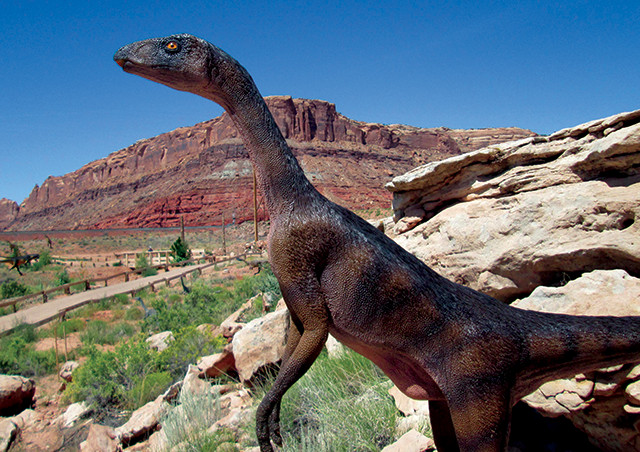
Life-sized sculpture of the theropod Coelophysis (New Mexico State Fossil) from the Moab Giants outdoor trail, with Late Triassic Chinle Group (lower slopes) and Early Jurassic Wingate Sandstone (orange cliff) in background. Credit: Martin Lockley.
But perhaps the best part of Moab Giants is the “PaleoSafari” trail, a kilometer-long open-air trail with about 130 full-sized reconstructions of dinosaurs based on the tracks and trackmakers of the Western Slope region.
© 2008-2021. All rights reserved. Any copying, redistribution or retransmission of any of the contents of this service without the expressed written permission of the American Geosciences Institute is expressly prohibited. Click here for all copyright requests.